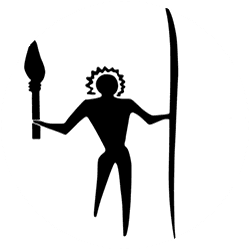Monumental Coolamon Bowl
An important and remarkably large coolamon. This immense bowl is carved from a burl (“wirree” in local aboriginal language), a rounded excrescence on a tree trunk which gives it the necessary bowl or canoe shape. The inside is magnificently carved with a decor of tightly spaced, minute grooves reaching across the greater length of the dish. The outside is decorated with long, adzed channeling.
Although principally used by women to prepare or collect food, bath babies, and carry goods the coolamon are generally made by men. They are usually made, such as the example here, from a hardwood tree or sometimes a piece of thick bark. In Central Australia, the bark of the “bean tree” was often used to make the coolamon. A piece of the outer bark is removed and molded over a fire to give it the distinctive curved sides. Deep ridges were made both inside and out using a quartz stone blade and the bark bowl needs to stand and dry for several days, with a piece of wood holding it open to prevent it from losing its shape. When made from hardwood a suitable tree was found with a pronounced burl or knot (“wirree”). This was then cut away from the trunk and hollowed-out to provide the containers form.
Coolamon also had ceremonial functions being used to gather and prepare pigments and potions as well as serving as food dishes for feasts. One such ceremony is the aromatic smoking one in which various types of aromatic leaves and grasses are burned, and the smoke is wafted around the participants to cleanse, heal and purify. Coolamon were rubbed regularly with animal fat, often that of the emu, to keep the wood in good condition. Coolamon is an anglicized version of the Wiradjuric word “guliman”.
Arrunta People, Central Desert (Alice Springs), Australia. Hardwood with a dry patina of age and stigmata of use. 93 x 35 x 40 cm. 19th/20th century.
Provenance
Two white paint inscriptions “COOLAMON (wooden water-dish) Alice Springs, Central Australia” on the center of the inside, and “4MC or 5 over E (?)” on one inner extremity and two paper labels : Large : “S.A.R., Passenger : I or T…., ADELAIDE TO LARGS (possibly Bay NSW)” which is a South Australian Railways luggage label; small label : N° 5.
A private estate in Normandy, France
















